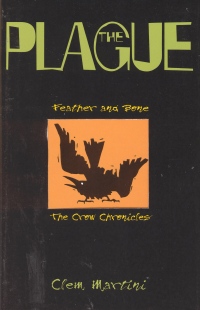| ________________
CM . . .
. Volume XII Number 7 . . . .November 25, 2005
excerpt:
The Plague, Clem Martini’s second installment of “Feather and Bone: The Crow Chronicles,” is suitable for middle school readers. This story is entertaining and gripping, and it should be suitable for any child who likes animal stories, fantasy, or quest tales. This second in the trilogy is far superior to the first. In The Plague, Martini has spun a riveting tale of one crow, Kyp, of The Mob fame, and his journey to rescue his friend Kym from human captivity. The story begins with the devastating effects of a rampant plague on many crow families, including Kyp’s. Although weakened and in poor condition, when Kyp discovers that Kym is gone, he is determined to find her. He sets off alone on what seems an impossible task. However, along the way, he makes many new friends and acquires quirky helpers, sometimes the unlikeliest of crows, and a surprising new family. In the nature of the best folk tales, Kyp and his new friends meet challenges, overcome hurdles, and triumph over the bleakest of odds. Their eventual rescue of Kym is an exciting adventure that showcases action, daring, cunning and, most of all, cooperation. In this story, unlike in the first offering of the “Crow Chronicles,” The Mob, Martini seamlessly and successfully integrates crow lore throughout the story. This time, he has managed to make all the old stories, history, and bits of wisdom seem interesting, relevant, and unobtrusive. Concepts, such as life turning points called “Taku”, which means, in crow lore, “when the owl turns away,” add richness and depth to the narrative, as do the creation stories that several of the crows tell at various intervals. It is a pleasure to see Martini turn what was a weakness in The Mob into a strength in The Plague. The only stylistic flaw marring The Plague is Martini’s odd use of point of view: he combines a first person voice with an omniscient point of view, to a very jarring effect. Otherwise, the narrative is smooth and beautifully written—a true pleasure of unfolding words. As well as being a beautifully written story full of exciting action and adventure, The Plague is a philosophical exploration of interrelationships, truth, perseverance and the meaning of life. Martini has created a highly successful story in The Plague, one which many young readers will enjoy. Readers should have no trouble following The Plague even if they have not read The Mob. Recommended. Michelle Superle (formerly Warry) teaches Composition and Children’s Literature at the University College of the Fraser Valley.
To comment
on this title or this review, send mail to cm@umanitoba.ca.
Copyright © the Manitoba Library Association. Reproduction for personal
use is permitted only if this copyright notice is maintained. Any
other reproduction is prohibited without permission.
NEXT REVIEW |
TABLE OF CONTENTS FOR THIS ISSUE
- November 25, 2005.
AUTHORS |
TITLES |
MEDIA REVIEWS |
PROFILES |
BACK ISSUES |
SEARCH |
CMARCHIVE |
HOME |
